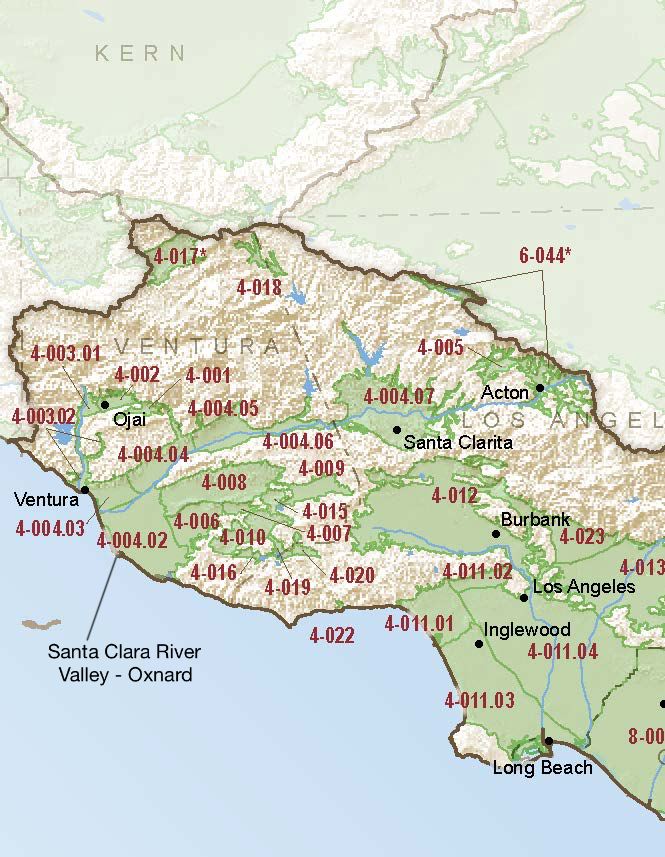Santa Clara River Valley – Oxnard
Statistics
- Basin Name
- Santa Clara River Valley – Oxnard
- Basin Number
- 4-004.02
- SGMA Basin Priority
- High
- Critically Overdrafted
- Yes
- Hydrologic Region Name
- South Coast
- Counties
- Ventura
At-A-Glance
Located in California’s South Coast hydrologic region, the Santa Clara River Valley – Oxnard subbasin is 57,887.91 acres in size. This High priority basin is home to an estimated 237,466 people (2010 value). It has approximately 1141 wells, of which approximately 68 are water supply wells. Groundwater accounts for approximately 67 percent of the basin’s water supply.

Basin Notes
2003: Bulletin 118 basin description
2014: CASGEM Basin Prioritization: High
2016: Basin boundary boundary modification accepted with the Las Posas and Pleasant Valley subbasins
Revised basin boundary description
2019: Basin boundary modification per DWR: “revises and aligns the shared boundary between the Mound and Santa Paula subbasins to align with the Santa Paula adjudicated boundary. The modification also revises the shared boundary between the Oxnard, Mound, and Santa Paula subbasins to align with the Fox Canyon Groundwater Management Agency’s boundary and the Santa Paula adjudication boundary, where applicable. The scientific modification along the northern boundary of the Mound subbasin follows mapped alluvial units using a more detailed, 1:24,000 scale, qualified map.” Priority status remains high and critically overdrafted. Basin prioritization comments –
- Groundwater levels: CRITICAL OVERDRAFT 2016 Source: DWR 1) CASGEM/WDL/GWIDS: Longterm hydrographs show groundwater level decline. Source: DWR 2) There is evidence for the occerrence of long-term overdraft in at least two of the groundwater basins of the District. Groundwater levels have generally been declining for periods of several decades in the Oxnard Plain and Pleasant Valley basins. While the factors causing declining groundwater trends may have varied among these two basins, long-term replenishment rates have not kept up with long-term withdrawal rates in either of them. Thus, these basins are considered by the District to be in a condition of long-term overdraft. – Annual Investigation and Report of Groundwater Conditions within United Water Conservation District, March 2016
- Salt intrusion: Although groundwater levels in the Oxnard Plain area (Mound, Oxnard, Santa Paula, Pleasant Valley, & Las Posas Valley) have been relatively stable or have shown an increasing trend, in the coastal regions this stability is largely due to seawater intrusion and results in water of unusable quality replacing high quality groundwater. Rising groundwater levels in the Las Posas Valley are a result of active management to increase groundwater recharge beneath the Arroyo Las Posas. Seawater intrusion began in the Oxnard Plain area by 1930s and was widespread as early as the 1940s. Changes in groundwater management, including pumping reductions, shifting of pumping locations, construction of the Freeman Diversion, and the operation of the Pumping Trough and Pleasant Valley pipeline systems have significantly reduced seawater intrusion, but seawater intrusion conditions persist. Source: CentralCoastGWReport-Aug2014.pdf 2) Water purveyors in the Piru, Fillmore, Santa Paula, Mound, and Oxnard subbasins include United Water Conservation District and Ventura County. United Water Conservation District operates surface water facilities to encourage groundwater protection through conjunctive use (UWCD 2012). Groundwater issues within the United Water Conservation District service area (which includes all of the basin) include overdraft conditions, sea water intrusion, and high nitrate concentrations. Source: Final Long Term Operations EIS, U.S. Bureau of Reclamation, Chapter 7
- Subsidence: Water-level declines in the basin have induced land subsidence that was first measured in 1939 and have resulted in as much as 2.7 feet land subsidence in the southern part of the Oxnard Plain. The model simulated a total of 3 feet of land subsidence in the southern part of the Oxnard Plain and as much as 5 feet in the Las Posas Valley subbasins. Model simulations indicate that most of the land subsidence occurred after the drought of the late 1920s and during the agricultural expansion of the 1950s and 1960s. The results also indicate that subsidence occurred primarily in the upper-aquifer system prior to 1959, but in the lower-aquifer system between 1959-93 owing to an increase in pumpage from the lower-aquifer system. “groundwater and oil and gas production are probably major causes in the Oxnard Plain subbasin, and tectonic activity is probably a minor cause (Hanson et al., 2003)” Source: U.S. Geological Survey (USGS); Michelle Sneed provided information for two continuous GPS stations (VNCO and P729), but neither are in the Oxnard subbasin. Source: UNAVCO
2020: January 13, 2020 – Groundwater Sustainability Plan submitted to DWR by the Fox Canyon Groundwater Management Agency
2021: November 18 — GSP approved by DWR
